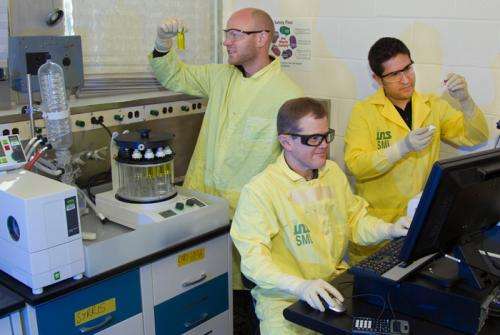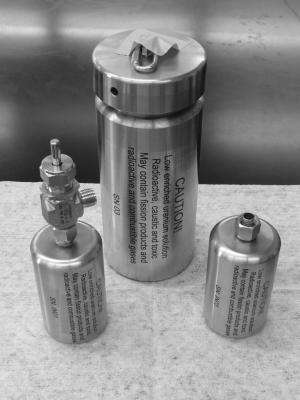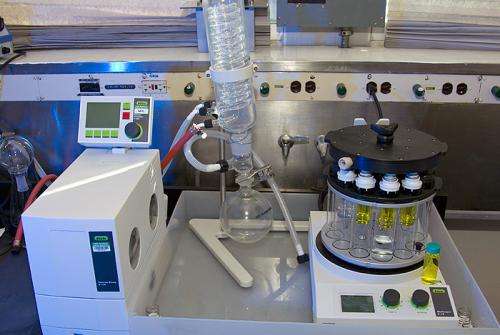Domestic production of medical isotope Mo-99 moves a step closer

(Phys.org) —Today, Los Alamos National Laboratory announced that for the first time, irradiated uranium fuel has been recycled and reused for molybdenum-99 (Mo-99) production, with virtually no losses in Mo-99 yields or uranium recovery. This demonstrates the viability of the separation process, as well as the potential for environmentally- and cost-friendly fuel recycling. Medical isotope production technology has advanced significantly now that scientists have made key advances in separating Mo-99 from an irradiated, low-enriched uranium (LEU) solution.
Low-enriched uranium as a source of Mo-99
Technetium-99m (Tc-99m) is the most commonly used medical isotope today, accounting for about 50,000 medical imaging procedures daily in the United States. Tc-99m is derived from the parent isotope Mo-99, predominantly produced from the fission of uranium-235 in highly enriched uranium targets (HEU) in aging foreign reactors. The North American supply of Tc-99m was severely disrupted when the Chalk River nuclear reactor in Canada experienced an outage several years ago.
The National Nuclear Security Administration's Global Threat Reduction Initiative (GTRI) implements the long-standing U.S. policy to minimize and eliminate the use of HEU in civilian applications. In support of this objective, GTRI is working with U.S. commercial entities and the U.S. national laboratories to develop a diverse set of non-HEU-based technologies to produce Mo-99 in the United States.

The U.S. national laboratories aid GTRI's programmatic mission by conducting research and development, engineering and design support, and proof of concept demonstrations. Toward this goal, GTRI has been working with Los Alamos to ensure its technical expertise is available to support GTRI's commercial partners, including Morgridge Institute for Research-SHINE Medical Technologies (MIR-SHINE), which proposes to use a particle accelerator to produce Mo-99 from a mildly acidic LEU solution.
The technical demonstration
In support of MIR-SHINE's Mo-99 production efforts, researchers at Los Alamos have successfully proven the technical viability of the initial stage of Mo-99 recovery from LEU solution through a direct scaled-down demonstration of the proposed industrial process.
To undertake the necessary experimental validation, Los Alamos researchers developed methodologies for preparing and analyzing uranium sulfate fuel, safely containing the fuel during irradiation at a Los Alamos Neutron Accelerator Science (LANSCE) facility and performing chemical flow-sheet testing using a separation apparatus applicable to both low and high levels of radiation.

With a short half-life of 2.7 days, Mo-99 is a high specific-radioactivity isotope. At production scale, the post-fission solution will contain only a very small concentration of Mo-99. Unlike traditional HEU-based processes, the challenge is to recover this material from a vast excess of LEU and leave the uranium in the same chemical form to allow for recycling.
The team found that nearly all of the uranium could be recovered after Mo-99 separations were performed. The LEU fuel that passed through the column separation process was irradiated again, and then once more the fission-generated Mo-99 was separated in high yield. When the same fuel was irradiated a third time, there was still no observable loss in the subsequent Mo-99 recovery. The results confirm the viability of both the Mo-99 separation process and uranium fuel recycling, which can lower operating costs and minimize waste generation.
Capability development and future plans
Los Alamos has a long tradition of producing radioisotopes for medical, industrial, environmental, national security and research applications. The Los Alamos team has now developed a wide suite of new capabilities and is poised to serve the GTRI mission for present and future applications.
Provided by Los Alamos National Laboratory
















